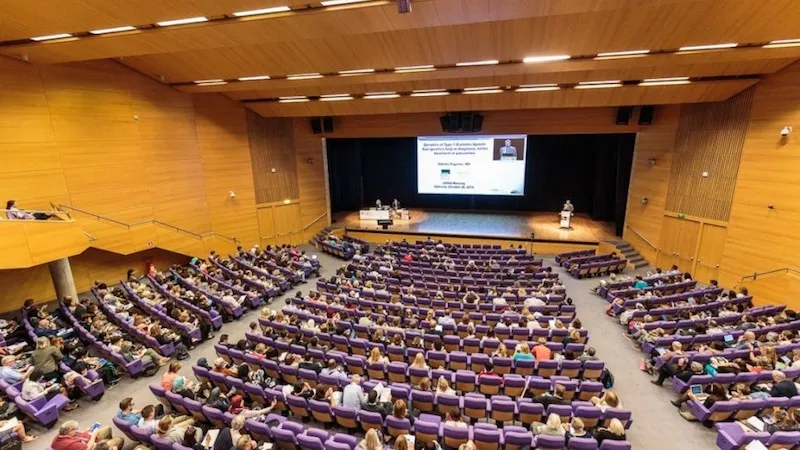From October 26 to 29, the Valencia Congresses Palace hosted the 42nd Annual Conference of the International Society for Pediatric and Adolescent Diabetes (ISPAD), the main event of the specialty at the international level.Ispad, who brings together pediatricians and educators who control children's and adolescent diabetes mellitus, thus celebrates for the first time in Spain its most important annual congress, attracting Valencia to more than 1,500 professionals from 60 countries, after having passed through cities like Brisbaneor Toronto.The Congress was chaired by Dr. Luis Castaño, pediatrician of the Biocruces Institute, professor at the UPV/EHU, and researcher in Diabetes del Ciberdem and Ciberer.We had the opportunity to talk to him.
More than 50 conferences.The tendency to make congresses with increasingly numerous and specialized sessions is confirmed, thus adapting to very specific needs of each professional.The program especially included five plenary sessions and 11 symposiums, but also many other smaller sessions.Finally, more than 400 communications from research groups were presented.
In addition to the plenary and symposium sessions, new formats such as “meetings with the expert” were implemented, a format in smaller groups (30 people) that allow much more interaction, and that worked very well.
Organization.The Board of Directors of Ispad delegates to Dr Castaño the scientific and organizational part.He has the help of two scientific committees, one international and one Spanish.With them, the doctor proposed the formative program and obtained green light.In terms of organization, he had the help of the German OPC of the company, kit, without local OPC and "with much support from the Palacio de Congresos and the Convention Bureau, which worked very well," the doctor tells us.
Spain works, and attracts.After America and Asia, Congress was held in Europe.The last European edition had been in Gothenburg, and without surprise the south and the Mediterranean were very attractive.In addition, according to Dr Castaño, "Valencia is a good city" for this type of congress, with a palace that he sees as very suitable for this size of Congress."Spain is a country that for congresses is very attractive and has a very good image" could verify the doctor when he presented the Spanish candidacy in Brisbane.
Another advantage, for this specialty: Mediterranean cuisine is positive to fight diabetes.So the letter of the Mediterranean diet in Congress was played, with fresh fruits in breaks and healthy food with fresh fruit and vegetables in the bags that were served for meals.It was almost impossible, not very agile, setting up a sitting for 1,500 ... but as Dr. Castaño reminds you, despite having food in bags, gastronomy was very worked with catering: because they are almost 12 hours per day and people haveto eat;because to be consistent with his medical message he needed healthy food;And because people expect good food in Spain.
So Spain was attractive and this characteristic and a very careful scientific program: there was record in the number of attendees.
A congress with a double conductive thread.Two key themes stood out during the three days of Congress:
Education, fundamental because in children's diabetes, the patient and family have to be well educated because they carry control.So Congress attended doctors but also educators, psychologists, nutritionists, nurses ... although the vast majority are doctors, especially pediatricians.
New technologies, both new devices (pumps and diffusers, glucose sensors) and as electronic solutions that help in the treatment of diabetes.
A milestone for Spanish pediatrics.According to the doctor, the event went to the entire specialtyA great success, strengthening the international image of Spain, both at a scientific and organizational level.Logically, hosting a congress of this type implies an important representation of Spanish doctors in the formative content, and a significant proportion (10%) of the speakers were Spanish, which represents important visibility and recognition.Another benefit is the greatest Spanish assistance, which rose from 5-6 doctors in the last edition in Australia, to 140 Spanish doctors in this edition, with the training opportunities that this means.

The importance of halls and coffee breaks.As the doctor tells us, the knowledge that is presented is very important but so are the relationships established outside the room, where common projects are raised and information and knowledge are exchanged more informally.A Congress allows professionals from different sites to be speaking for three days, which allows international collaboration programs to be launched.
Congress without paper.This edition was the first paperless and with an app, in line with the sustainable policy of the palace: there was no printed or bag program.The change worked very well."It gives us flexibility of last minute changes," says Dr Castaño.This change was made with an important support, with experts in the app clarifying and facilitating its operation.The app was used to transmit information, program, but also to connect with other attendees, make live vote, ask questions.The questions were asked with the app, the moderators had screen and managed the questions.A solution of written questions that encourages those who do not want to speak in public.Social networks were not used.
The posters were also electronic, in a wide area.Is electronic poster acceptance problems in some other cases?No, according to Dr. Castaño, if it is well organized, they are well accepted.
The meeting was supported by the main national medical societies: Spanish Society of Pediatric Endocrinology, Spanish Diabetes Society, the Center in Biomedical Research in Diabetes Network (CIBERDEM) and Obesity (CIBEROBN), as well as different associations of people with people with people withlocal and state diabetes.
In the end a positive impact for the city: more than 2.2 million euros.


